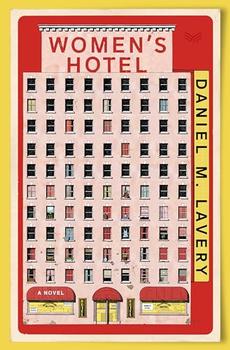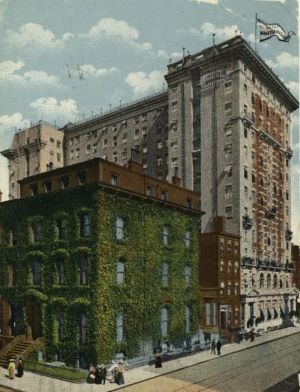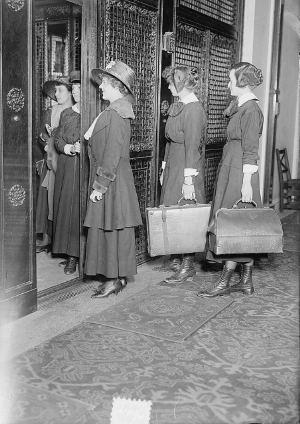Summary | Excerpt | Reading Guide | Reviews | Beyond the Book | Read-Alikes | Genres & Themes | Author Bio

A Novel
by Daniel M. LaveryThis article relates to Women's Hotel
 In Women's Hotel, Daniel Lavery introduces readers to the fictional Biedermeier, which is based on the real-life phenomenon of residential hotels for women only that existed in New York City throughout the 20th century. As women began working outside the home on a mass scale, they traveled in droves to the city to make lives for themselves, but there was still a social stigma surrounding the prospect of a woman living alone, and/or in the vicinity of men. The women's hotel, something like a dormitory, was viewed as a more respectable option, without being as didactic as the religious-run "moral homes," which required women to follow a list of behavioral rules and attend regular worship services. Typically, residents of these hotels were permitted to have male guests in the communal spaces, but men were prohibited from the individual private rooms (as in Lavery's novel, this is a rule that was most certainly broken with regularity).
In Women's Hotel, Daniel Lavery introduces readers to the fictional Biedermeier, which is based on the real-life phenomenon of residential hotels for women only that existed in New York City throughout the 20th century. As women began working outside the home on a mass scale, they traveled in droves to the city to make lives for themselves, but there was still a social stigma surrounding the prospect of a woman living alone, and/or in the vicinity of men. The women's hotel, something like a dormitory, was viewed as a more respectable option, without being as didactic as the religious-run "moral homes," which required women to follow a list of behavioral rules and attend regular worship services. Typically, residents of these hotels were permitted to have male guests in the communal spaces, but men were prohibited from the individual private rooms (as in Lavery's novel, this is a rule that was most certainly broken with regularity).
 One of the first of these hotels to open was the Martha Washington, in 1903. The hotel offered a total of 650 rooms, with 500 available for permanent residents. These were largely "professional" women, including teachers, nurses, and stenographers, but the hotel also served as the headquarters for the Interurban Woman Suffrage Council. Its amenities (for those who could afford to make use of them) included a manicurist, shoe-polishing parlor, drug store, and tailor. Residents at various times included poet Sara Teasdale and actor Veronica Lake. The opening of the Martha Washington was met with intrigue, fascination, and open mockery. The New York Times provided an account from a woman visitor: "She said that it was impossible for her to eat her dinner in the dining room, as she had never seen so many women gathered together without the relief of a black coat...After dinner women thronged about the office and lobbies, and it seemed an Adamless Eden."
One of the first of these hotels to open was the Martha Washington, in 1903. The hotel offered a total of 650 rooms, with 500 available for permanent residents. These were largely "professional" women, including teachers, nurses, and stenographers, but the hotel also served as the headquarters for the Interurban Woman Suffrage Council. Its amenities (for those who could afford to make use of them) included a manicurist, shoe-polishing parlor, drug store, and tailor. Residents at various times included poet Sara Teasdale and actor Veronica Lake. The opening of the Martha Washington was met with intrigue, fascination, and open mockery. The New York Times provided an account from a woman visitor: "She said that it was impossible for her to eat her dinner in the dining room, as she had never seen so many women gathered together without the relief of a black coat...After dinner women thronged about the office and lobbies, and it seemed an Adamless Eden."
The opening of the Martha Washington was followed by several other hotels, including the Sutton, the Virginia Hotel, and the Hotel Rutledge. But the most famous, and perhaps the most high-class, was the Barbizon. It could house 700 and featured a communal library, swimming pool, gym, garden, and lecture halls, as well as a hairdresser and dry cleaner, among other amenities. According to The New Yorker, applicants for residency were carefully screened, with letters of recommendation required and grades assigned based on age and appearance: "A's were for women under twenty-eight, while those over thirty-eight were lucky to get C's." The Barbizon housed a number of models, writers, and actors, including Grace Kelly, Liza Minnelli, Sylvia Plath (who wrote about her time here in The Bell Jar), and Joan Didion. During its heyday, the residents of the Barbizon were likely exclusively white. Artist and writer Barbara Chase is believed to have been the first Black resident of the Barbizon in 1956, while serving as a guest editor for Mademoiselle magazine.
The Barbizon went coed in the 1980s, and its rooms have since become condos (with going rates from $750K to $4.5 million). The Martha Washington has been bought and revamped multiple times, reopening as a series of hotels over the past 20 years, most recently as the chic Redbury New York Hotel in 2016, which rebranded as 29 E. 29 Hotel, before closing altogether.
Image on Hotel Martha Washington postcard (1907), from The New York Public Library
"Arriving — Martha Washington Hotel" (c. 1915–1920), from Library of Congress
Filed under Places, Cultures & Identities
![]() This article relates to Women's Hotel.
It first ran in the October 16, 2024
issue of BookBrowse Recommends.
This article relates to Women's Hotel.
It first ran in the October 16, 2024
issue of BookBrowse Recommends.
They say that in the end truth will triumph, but it's a lie.
Click Here to find out who said this, as well as discovering other famous literary quotes!
Your guide toexceptional books
BookBrowse seeks out and recommends the best in contemporary fiction and nonfiction—books that not only engage and entertain but also deepen our understanding of ourselves and the world around us.